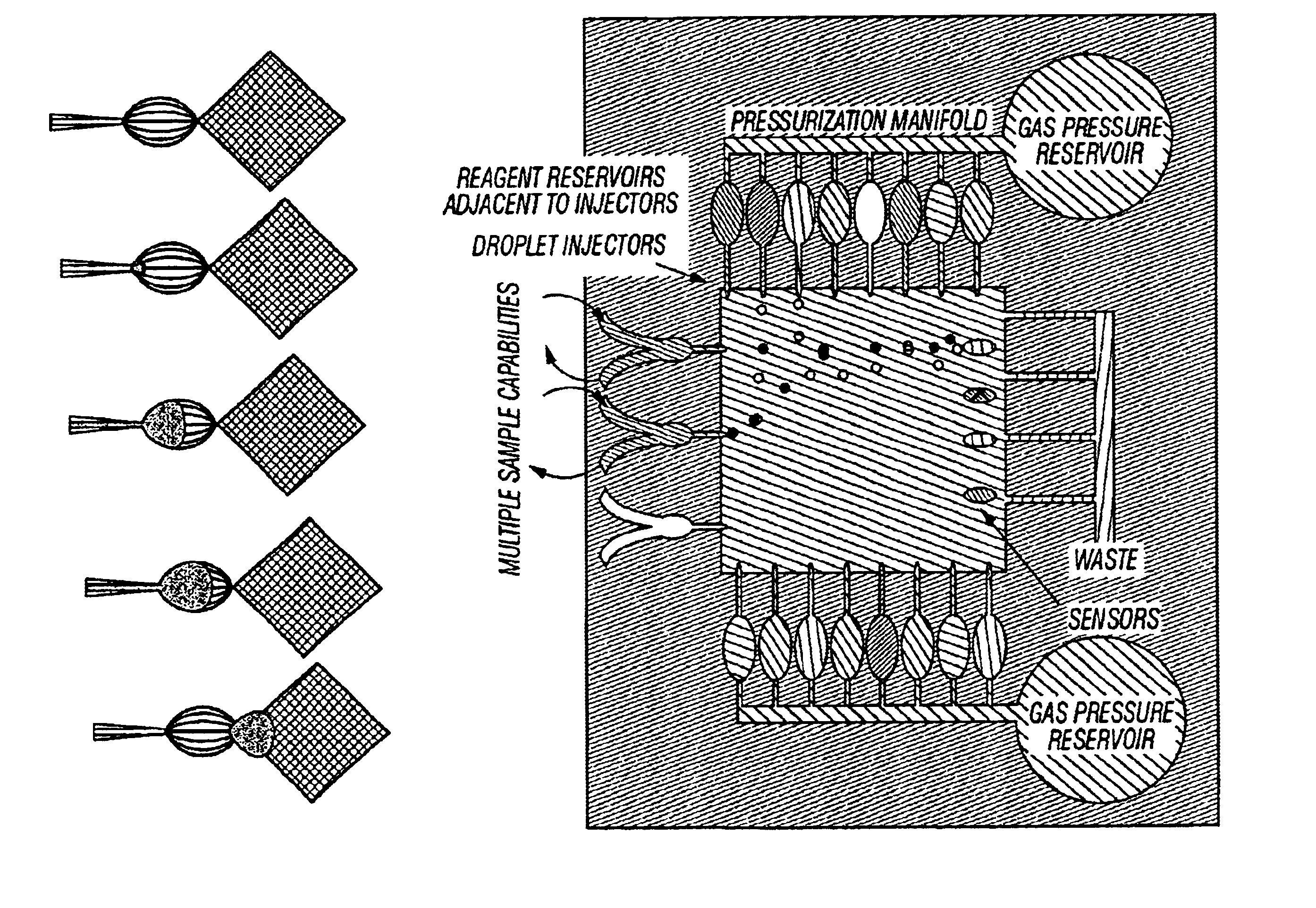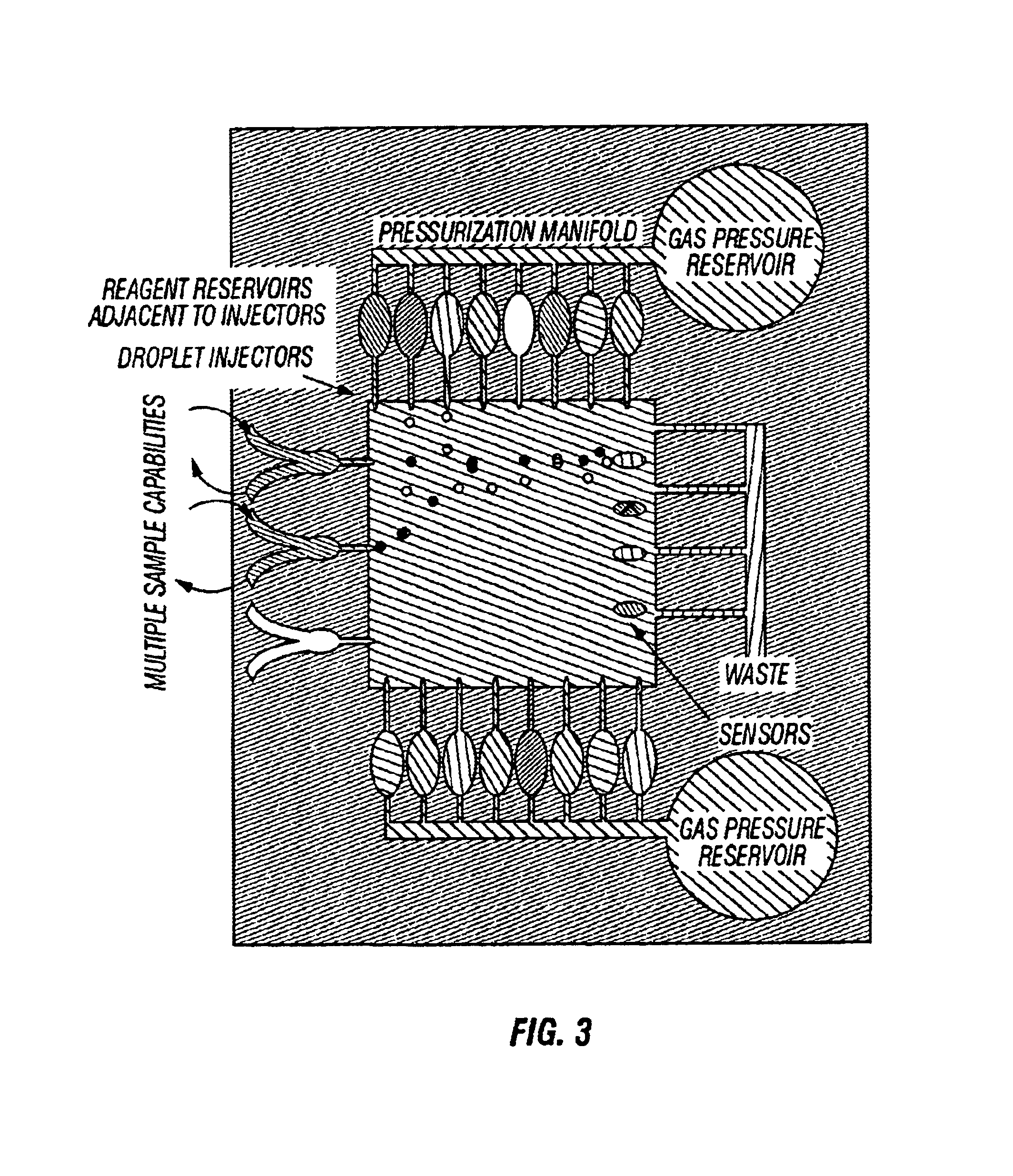Apparatus and method for fluid injection
a fluid injection and apparatus technology, applied in the field of fluid processing, can solve the problems of large improvement room, lack of flexibility of current microfluidic devices, and devices using micro-scale implementations of traditional approaches
- Summary
- Abstract
- Description
- Claims
- Application Information
AI Technical Summary
Benefits of technology
Problems solved by technology
Method used
Image
Examples
example 1
Programmable Fluid Processor
[0071]In one embodiment, packets of metered size may be injected from one or more inlet ports on the sidewall(s) of a programmable fluid processor (PFP), such as the apparatus described in U.S. patent application Ser. No. 09 / 249,955, now U.S. Pat. No. 6,294,063 by dielectrophoresis into an immiscible carrier liquid covering a reaction surface.
[0072]Fluid flow may be made to be digital, rather than continuous, in the PFP, and the packets may be controlled electronically. The only moving parts in such a setup will be the fluid packets, and no valves or mechanical pumps will be required. Injectors according to the present disclosure may be attached directly to adjacent reservoirs containing reagents or any other suitable fluid or gas. Packets may vary widely in size, but in one embodiment may have diameters from about 20 to about 100 μm. The packets may have volumes that vary widely, but in one embodiment the volumes may be in the 0.1 to 1 nL range. On-chip ...
example 2
Fluid Processing System
[0076]FIG. 4 shows a block diagram of a fluid processing system that uses injection technology in accordance to the embodiments disclosed herein. On the right side of FIG. 4 is shown a fluidic processing apparatus termed the “BioFlip.” This may vary in size significantly, but in one embodiment its size may be about 3″×2″×0.5″. It may be in the form of a cartridge equipped with no more user interface than an alarm and a small LCD. It may be self-contained and operate autonomously. It may be programmable by a handheld unit (Windows CE or Gameboy-style) shown on its left.
[0077]The packet injection of material from the sample and reagent reservoirs may be controlled by dielectrophoresis with a no moving parts, the packet size may be controlled by varying parameters discussed above and listed in Table 1 such as orifice size and / or pressure, the packets may be moved anywhere on a two-dimensional array via dielectrophoresis or another suitable manipulation force, the...
example 3
Pressure Relationships
[0080]The static pressure differential necessary to maintain a packet is generally expressed by: Pi n-Pext=γr
where Pin and Pext are the internal and external hydrostatic pressures, γ is the surface tension and r is the radius of the packet. Thus, the pressure differential necessary to maintain a packet is inversely proportional to the radius of the packet.
[0081]Since water adheres to hydrophilic glass, injected packets tend to remain attached to the tip of the injector pipettes unless the outer surface is made hydrophobic. This may be done by dip-coating the pipettes in a anti-wetting agent such as, but not limited to, Sigmacote®, a silicone solution in heptane, or a fluoropolymer, such as PFC1601A from Cytonix, Inc.
[0082]The pressure inside a packet is inversely proportional to its radius. Therefore, if the meniscus is flat at the injector tip, it has infinite radius and zero pressure. As fluid flows to form a nascent packet, the meniscus radius decreases un...
PUM
| Property | Measurement | Unit |
|---|---|---|
| Fraction | aaaaa | aaaaa |
| Fraction | aaaaa | aaaaa |
| Fraction | aaaaa | aaaaa |
Abstract
Description
Claims
Application Information
 Login to View More
Login to View More - R&D
- Intellectual Property
- Life Sciences
- Materials
- Tech Scout
- Unparalleled Data Quality
- Higher Quality Content
- 60% Fewer Hallucinations
Browse by: Latest US Patents, China's latest patents, Technical Efficacy Thesaurus, Application Domain, Technology Topic, Popular Technical Reports.
© 2025 PatSnap. All rights reserved.Legal|Privacy policy|Modern Slavery Act Transparency Statement|Sitemap|About US| Contact US: help@patsnap.com



